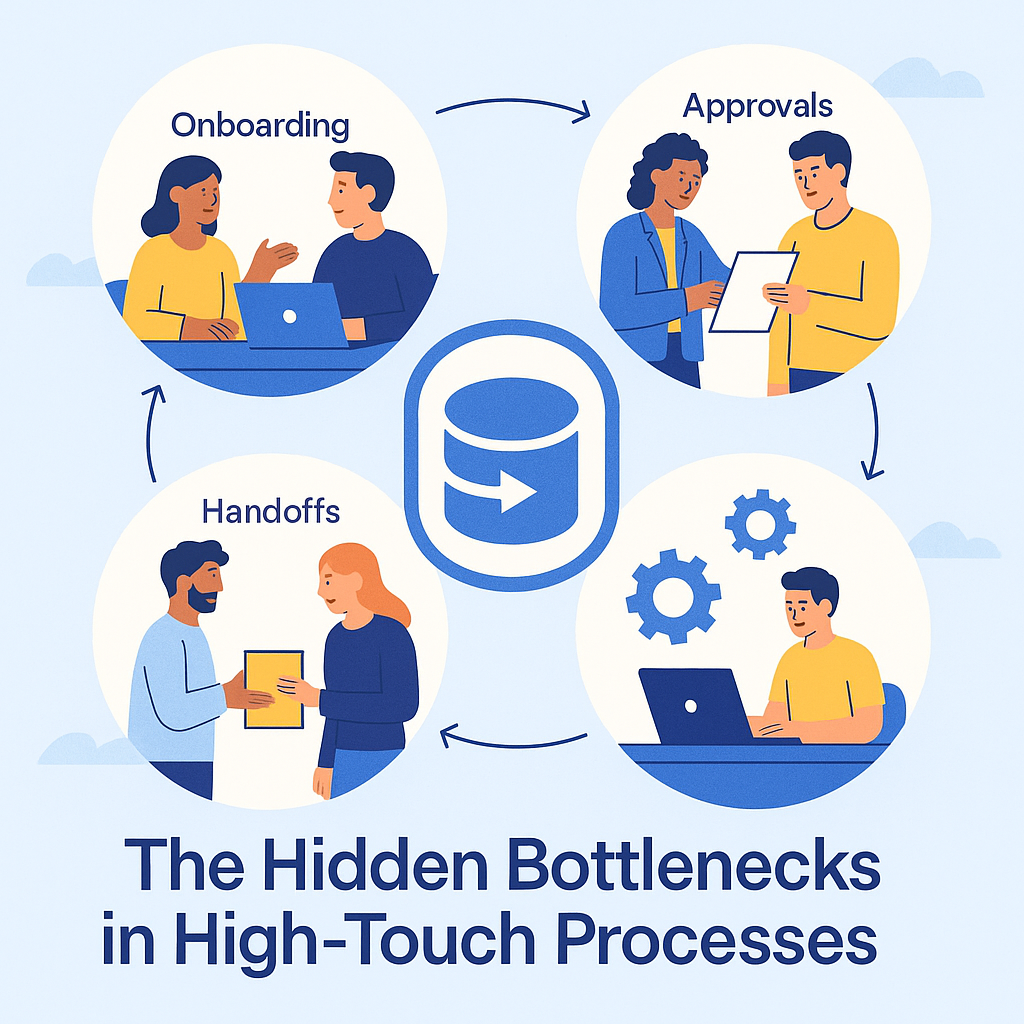
In the world of private equity, playbooks are full of the usual suspects: consolidate vendors, renegotiate contracts, standardize platforms. These tactics work—but they rarely touch the most complex, failure-prone part of a portfolio company’s operations: the human-led processes.
We’re talking about onboarding, approvals, sales-to-CS handoffs, budget planning, incident response, hiring, escalations. Anywhere multiple stakeholders are involved, decisions are interdependent, and tribal knowledge fills in the gaps—there’s friction.
These high-touch processes are hidden bottlenecks. They don’t show up on the P&L, but they cost real time, energy, and opportunity. Left unaddressed, they create drag exactly where portfolio companies need to be moving fast.
So how do you fix them? Not with rigid workflows or massive ERP overhauls. You fix them with automation that’s built for humans—flexible enough to support decision-making, yet structured enough to keep things moving.
High-touch processes are often assumed to require human coordination by default—and while that’s true, it’s also misleading. Humans may need to make the decisions, but they don’t need to manage the process around them manually.
Think of:
These aren’t complex from a logic standpoint—they’re just messy. And in most cases, the mess is avoidable.
Here are a few common examples from real PE-backed environments:
Once a deal closes, who ensures the right onboarding sequence happens? Who sets expectations, assigns owners, and follows up when a step is missed? Often, no one—and so the customer experience suffers.
Department heads submit plans via email, finance consolidates them into spreadsheets, execs hold meetings to resolve overlaps. Revisions are manual, context is lost, and the process drags on for weeks.
Employees submit vendor requests. Someone needs to check terms, compare quotes, loop in legal, and finally secure sign-off. But if there’s no central process, every purchase is a fire drill.
Each of these is human-heavy but rule-bound. They don’t require deep AI—they require structured execution and better coordination. That’s where targeted automation shines.
From an operating partner’s perspective, the mandate is clear: create enterprise value quickly, efficiently, and repeatably. Bottlenecks in high-touch processes work against all three:
Worse, they’re hard to spot. Because they happen “in the middle” of things—in between systems, between teams—they rarely get documented, tracked, or measured.
But if you automate around them, everything else works better: onboarding flows faster, approvals are more accountable, cross-functional work gets done on time.
This isn’t RPA. And it’s not just task management either. Automation for human-involved workflows needs three things:
You want a defined process—but with flexibility to accommodate branching paths, conditional decisions, and delays. Think of it like a guided lane for humans, not a trap.
Every task should have an owner, deadline, and context—automatically. No more chasing people or wondering “who’s got this?”
Use AI agents for what they’re good at: summarizing inputs, triaging issues, or suggesting actions—without removing the human decision-maker.
That’s the Mello approach: automation built for processes where humans are essential, not optional.
Once a process is structured, you can layer on AI agents to speed things up even further. In a high-touch process, that might look like:
The key is that AI doesn’t take over the process—it enables it to move faster and with less effort.
For PE-backed companies, especially those running lean, automation can feel intimidating. But you don’t need to boil the ocean. Here’s how to start:
You’re not building an enterprise system—you’re giving teams superpowers.
High-touch processes won’t disappear. Humans will always need to make decisions, approve exceptions, and handle nuance. But how those processes run is entirely up for grabs.
If you’re an operating partner or portfolio executive looking to improve execution, the biggest gains often aren’t in systems—they’re in the spaces between them. That’s where workflows live. That’s where delays start. And that’s where automation built for humans can unlock real, immediate value.
With Mello, you don’t have to choose between structure and speed, or people and process. You can have both—and that’s how operational alpha is built.